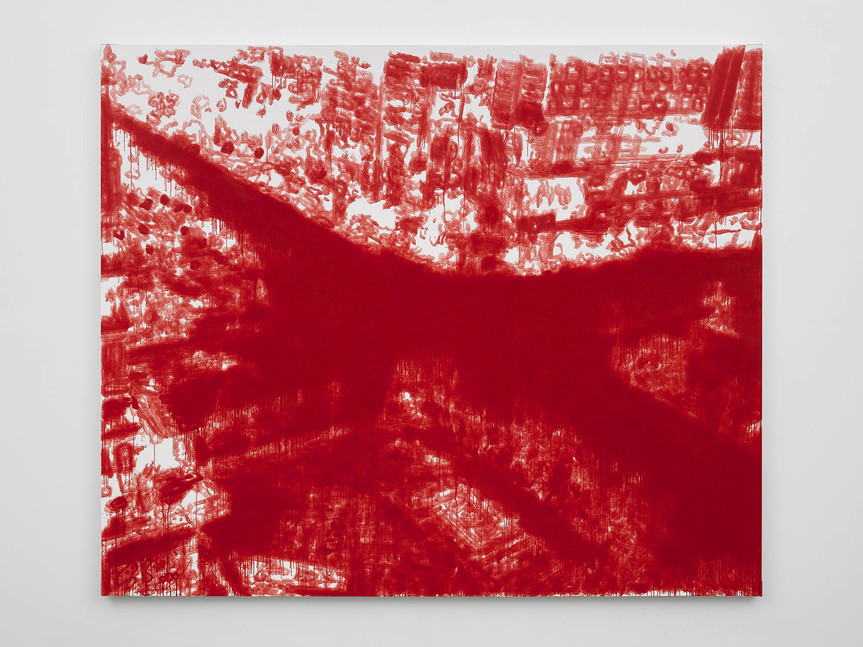-
From Current Issue
-
- Editor’s Letter Fire in the Heart
- Reviews I Gusti Ayu Kadek Murniasih
- Reviews 11th Seoul Mediacity Biennale: “One Escape at a Time”
- Dispatch Networked China
- One on One Monira Al Qadiri on Yukio Mishima
- Essays The rise of independent art spaces in pandemic-era Shanghai
- Features Tuan Andrew Nguyen
- Table of Contents
- Web Exclusives
- Archive
- Subscribe

R
E
V N
E
X
T
Installation view of LIU XIAODONG’s “Weight of Insomnia” at Lisson Gallery, London, 2019. All images copyright the artist; courtesy Lisson Gallery, London / New York.
In his 1914 neorealist manifesto, Charles Ginner rails against the “academism” of “weak or commercial painters,” who adopt the methods of creative artists and derive formulae from them, becoming “Formula-Machines.” To circumvent such “academism,” Ginner advocates for artists to anchor their works in their “personal vision of nature and attitude towards life.” It is somewhat ironic then that a century later, one of China’s foremost neorealist painters, Liu Xiaodong, has been creating works with an automated painting robot. The contraption, the series of works it has produced, and Liu’s new exhibition at London’s Lisson Gallery are entitled “Weight of Insomnia.”
Liu has spoken in the past about his interest in objectivism, saying that, in his paintings, each stroke of his brush follows and corresponds to a new glance at his subject. His early compositions nonetheless have a personal inflection—a slight skewing of perspective and form that is recognizable yet not totally predictable. A machine such as Weight of Insomnia may be capable of inflection, but only as a result of pre-programmed algorithms—the kind of formulae Ginner distained. Any capacity it has for unpredictability is not a function of the “painter,” but of the subject. All of the “Weight of Insomnia” paintings that were on display at Lisson depict urban landscapes. These scenes are based on data gathered by cameras trained on different locales. As the places morph—with people and objects moving through them, or fluctuations in the weather—the robotic brush adds these changes to the canvas in a single color regardless of what is underneath. In the works showing more populated cities, such as Weight of Insomnia (Beijing) (2016) and Weight of Insomnia (Karlsruhe) (2017–18), the result is densely saturated patches of paint representing particularly busy thoroughfares, which, as a way of depicting the passage of time, draws parallels with overexposure in photography. In fact, it is relevant to ask what the substantive difference is between this automated approach and photography: one is chemical, the other mechanical, but each relies on a configuration of either optics or coded instructions that translates light into a recognizable image. The scope for expression in Liu’s approach appears minimal.
There are details in some of these paintings that create a momentary thrill. The linear clouds in Weight of Insomnia (Karlsruhe) or Weight of Insomnia (Gwangju) (2018) transform the characteristics of the originals into a satisfying uniformity of shapes. Likewise, watching the machine paint a likeness of London’s Trafalgar Square live in the gallery is briefly exciting, but only as a novelty. As with photography, there is something similar to Walter Benjamin’s problem of “aura”—whereby an art object loses something of its uniqueness and effect through mechanical reproduction—at play, and it is difficult to stay enthused about these paintings for long. The point is hammered home by one of Liu’s earlier, hand-painted works, Time (2014), which portrays a group of students sat on a patch of ground in Gwangju during the 1980 pro-democracy uprising. In addition to the element of human unpredictability visible in the technique, the painting is superior because it carries inside itself a “Why?”—why, for instance, would a machine ever choose to depict such a moment in history?
Perhaps “Weight of Insomnia” is better viewed as a conceptual, rather than painterly, project. In keeping with another tenet of neorealism in most disciplines, it has an implied social element, addressing concerns with rapid urban expansion, surveillance and the anxieties that go with them. According to this reading, it is unsettling that the artist willingly turns over his position to a surveillance apparatus, distancing himself from the subjects who, in his other paintings, are depicted with objectivity, but also affection.
Viewed from a conceptual standpoint, “Weight of Insomnia” certainly raises questions, but is more effective at turning our attention to the ongoing evolution of painting and the art world than to society at large. Perhaps being ungenerous, the exhibiting of a device like this could be seen as just another manifestation of the experience economy in art, where spectacle and novelty override all else. The machine is not the first of its kind—the robotics community has even been running a robot painting competition since 2016—but it was presented with a sufficiently straight face that questions about the state and future of painting can arise in earnest, and that is worth something.
Ned Carter Miles is the London desk editor of ArtAsiaPacific.
Liu Xiaodong’s “Weight of Insomnia” is on view at Lisson Gallery, London, until March 2, 2019.
To read more of ArtAsiaPacific’s articles, visit our Digital Library.




















